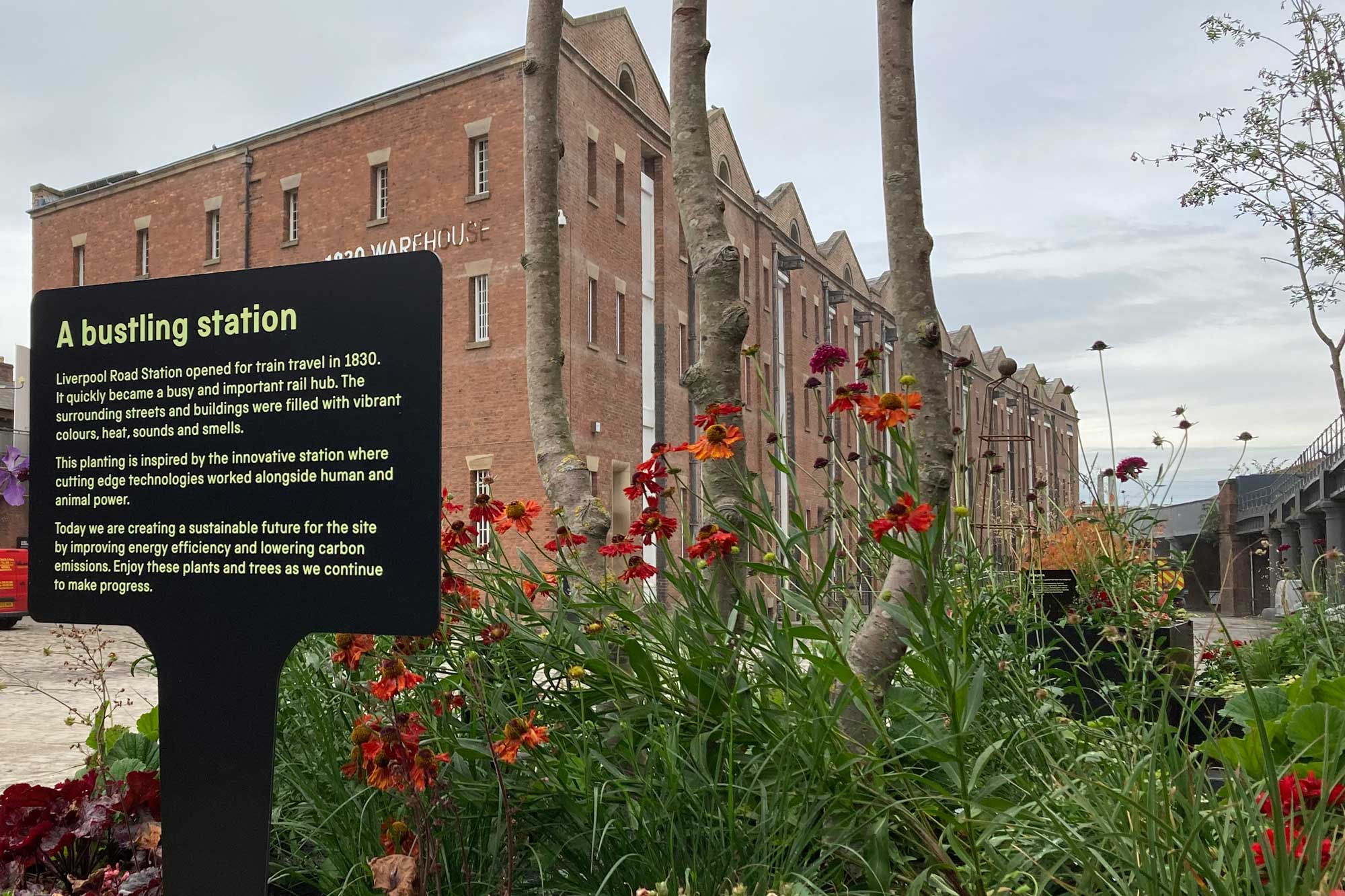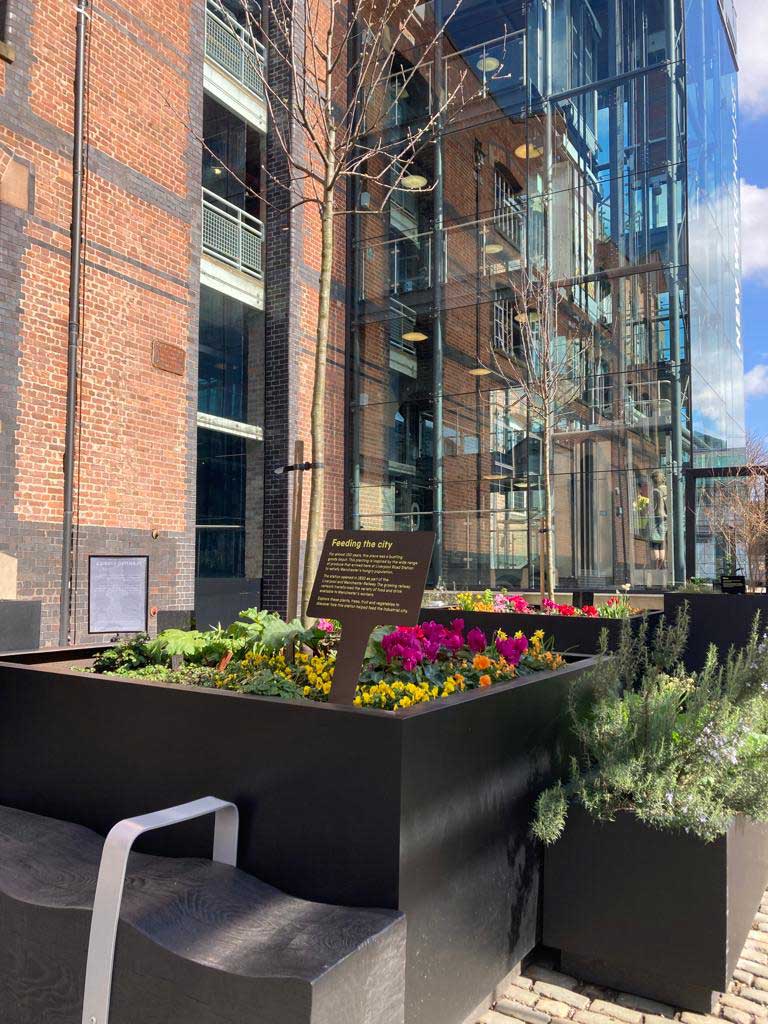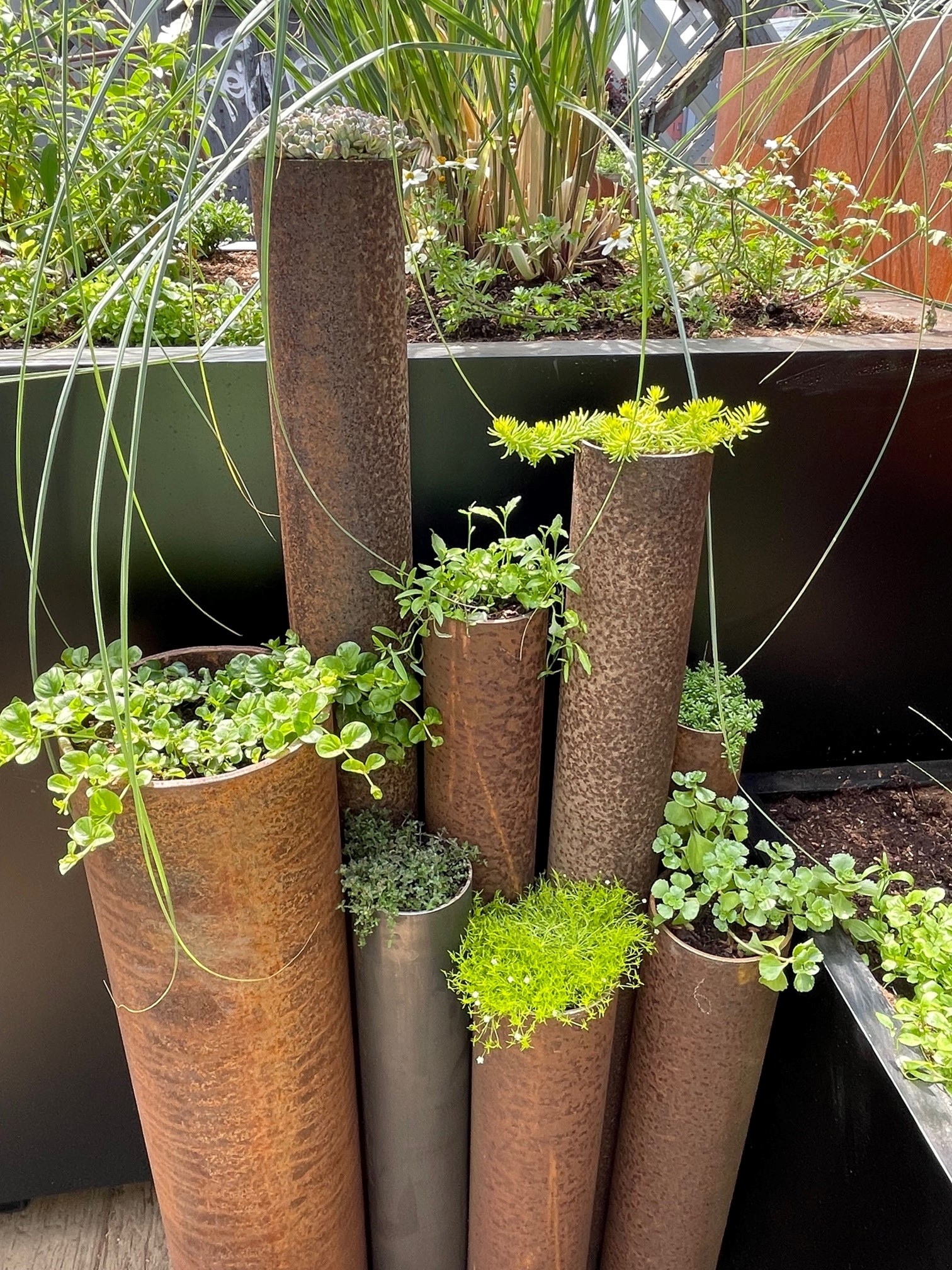What colours do you think of when you imagine life at the world’s first inter-city railway station in the heart of 1800s industrial Manchester? Perhaps the black of the coal used to fuel engines, the grey of the smog and steam, or muted tones of dirty clothes from days spent loading goods onto railway carriages?
If that’s what you thought of, you’re not wrong. Industrial Manchester would certainly have been a grubby place, and nowhere more so than the station. But it was also vibrant, alive with new sights, sounds and smells. Working at the station, you might also have spied the bright colours of imported goods arriving for delivery across the city, or colourful textiles leaving for distribution to the rest of the world. We’ve brought these stories to life by planting a brighter picture of Manchester’s past in our own outdoor spaces.
Planting stories
The Liverpool and Manchester Railway was the world’s first steam-powered, inter-city railway, designed to transport both passengers and goods. The Manchester terminus was Liverpool Road Station, which is now home to us, the Science and Industry Museum. When the railway opened in 1830, it sparked a revolution in trade and travel, and changed Manchester’s outlook forever. For almost 150 years, the station was a bustling hub of people, animals and machines, keeping produce, raw materials and finished goods moving in and out of the industrial city, and connecting Manchester with the world.

To help tell this story, we’ve been creating colourful gardens in our historical Lower and Upper Yards since 2020. They have been filled with plants, trees and flowers to represent the foods that would have once been transported on the railway to feed Manchester’s growing population, the materials that arrived at the station to fuel the city’s booming industries, and the goods that came to be distributed across the world.

The growing railway network transformed the variety of food and drink available to Manchester’s workers. Our garden uncovers how the station helped to feed the industrial city. In the summer it produces its own fruits and vegetables, including apples, beans and tomatoes, the likes of which would once have been quickly unloaded from railway wagons at the station and collected by delivery drivers for distribution across the city.

Among more than 50 species of plants in the garden are flax, which produce stem fibres that can be spun and woven into fabric such as canvas. Workers at the station would have used canvas to cover railway wagons, protecting their precious cargo from Manchester’s notoriously wet weather. We’ve also included chamomile, the flowers from which were used to make yellow dye that Manchester’s textiles manufacturers would have used to transform plain cloth into colourful, attractive fabric.
Another theme of our planting is the heat and fire that would have powered the railways. Workers spent long hours in dirty, hot conditions shovelling coal into firebox furnaces. The vivid, colourful flames this would have created are represented by red, orange and yellow flowers that blossom in the summer. In the Lower Yard, these vibrant bursts of colour are contrasted against the glossy, maroon-black leaves of Heuchera ‘Obsidian’ Coral Bells, which represent the abundance of coal that would once have fuelled the site.

The planting displays also help to paint a picture of the area surrounding the museum in the 19th century—a theme we explored further from July 2022 through a partnership with the National Trust.
We were one of four local partners that created the first unique garden areas in the ‘sky park’ at Castlefield Viaduct. We filled our plot with plants that engage the senses and encourage visitors to take an active role exploring the local historical landscape, as well as understand the story of the structure itself and how it relates to our own site.
The interconnectivity brought about by the railways plunged Manchester into a new era of steam and speed, broadening horizons and creating new opportunities. Liverpool Road Station was a catalyst for the subsequent railway infrastructure that sprung up around Castlefield to support the demands of expanding industries and the increasing population. The area became an established hub for Manchester’s goods transportation network. Warehouses and new train stations were built and in 1891 construction began on the viaduct to connect these buildings via a railway line. For the next seven decades, the viaduct was used to carry heavy rail traffic in and out of the area, until it finally closed in 1969. It reopened last year as an urban park that celebrated the nature, beauty and history of the structure.

We took inspiration from this industrial history to inform our display at the viaduct, which has now moved to a new home in our Lower Yard and will be available for visitors to explore later in the year. In the summer, fluffy white plants, such as Sanguisorba albiflora, spring up to represent the plumes of steam from the locomotives, which would have left trails across Manchester’s skyline, and blue flowering plants, including lobelia, have been positioned to cascade and flow, representing the essential relationship the first railways had with water. Decorative pipework emulating industrial chimneys are displayed alongside hand-cut trellis panels covered in patterns to evoke the connectivity brought about by the rail networks.
Sustainability
The green spaces have been designed to blossom with different plants throughout the year, providing areas to sit, explore and reflect on the story of the station’s essential role in supporting the industrial revolution. As well as bringing to life the story of the site, the gardens also highlight our future aspiration to become greener. Technology continues to change our site, where we’ll soon be using water pumped from deep underground to heat our historic buildings. These cleaner energy sources, combined with changes to the way we insulate our museum, will save us 515 tonnes of carbon every year.
The materials and structures used across our garden displays have been specifically selected to maximise sustainability. Planting includes long-lasting perennials and evergreen shrubbery to keep the botanical beds blooming year after year, supporting biodiversity while helping to reduce our carbon footprint.
Here, Alex Froggart—the landscape gardener who has helped to create the displays—explains more about the considerations that were made to ensure the gardens are sustainable into the future.
Caring for our gardens
A team of dedicated volunteers maintain the displays year-round and bring the narratives alive for our visitors. Hear from Brenda, gardening volunteer, about how she and her colleagues care for the planters and help to bring the stories they tell to life.
The buildings we now inhabit are a key part of Manchester’s history and transformed Castlefield into the hub of the city’s industrial heritage. Today, as a museum we are a key part of transforming the area into a lively area for culture and a destination for people looking to explore Manchester’s fascinating past and aspirations for the future.
Our planting has introduced a new, multi-sensory dimension to our story telling, giving visitors more to explore in our outdoor spaces and reflecting the vibrancy of a site that gave rise to ideas that changed the world.